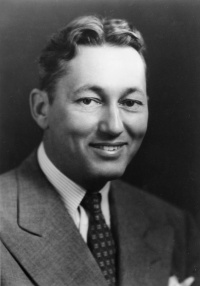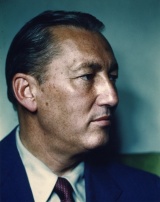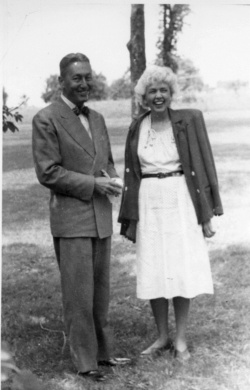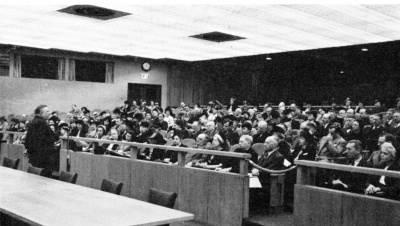James S. Perkins
Early years
James Scudday Perkins, Jr. was born June 29, 1899. His family lived in Patterson, Louisiana, a small town on a bayou in the south central region of the state, where the principal employer was a cypress sawmill. He registered for the draft in World War I, but did not have to serve. At that time he was a clerk in a grocery owned by the family.[1] He entered the University of Cincinnati to study civil engineering, but switched to the study of art. He attended the Art Academy in Cincinnati, then the Art Students' League in New York, and the Grand Central School of Art.[2]
While in Cincinnati, he met Kathrine Galbreath, another art student, and they married. The couple had one daughter, Torre Perkins, and the family settled in Cincinnati.
Theosophical work
He was a founding member of a branch of the American Theosophical Society in Cincinnati, which formed on December 20, 1928. He was lodge president for six years, and also served five terms as president of the Ohio Theosophical Federation.
James Perkins was elected to the Board of the Theosophical Society in America in 1936. Three years later he began the first of three terms as Vice-President in the administration of Sidney A. Cook. During all these years, Perkins frequently lectured for the Society all over the United States. His lectures addressed a wide range of topics of interest to the general public and Theosophists, but often touched on art and beauty. He was also very concerned with current affairs, such as "Men of the Atomic Age" in 1948, following the Hiroshima bombing, and "The Significance of Man's New Space Awareness" following the 1957 launch of the Russian satellite Sputnik.
Years as President
In 1945 Mr. Perkins assumed the Presidency of the Theosophical Society in America, when Sidney A. Cook resigned to become International Vice-President in Adyar, and served until 1960. National Secretaries during his administration were Ann Werth (until 1950) and Caroline Tess. These are some of the accomplishments of the Perkins years:
- 1945 - Formed six committees concerned with the growth of the Society:
|
Field Technique |
Worker Training |
- 1945 - Transformed the Publicity Department into the Department of Information, under the direction of Joy Mills.
- 1945 - Began publishing Discovery, a small leaflet that was published regularly for ten years as a tool for lodges to promote Theosophical concepts and their own local programs.
- 1946 - Introduced the "Spotlight" program of national lecturers to "Speed the Popularization of Theosophy". Among the lecturers were Kathrine Perkins, Joy Mills, Alan Hooker, Nedra Ruder, and Iris White, and their efforts led to increase in membership and establishment of several new branches.
- 1947 - Established a new line of paperbacks called Quest Books in the Theosophical Publishing House, with a bequest from Herbert A. Kern, Sr.
- 1947 - Established a scholarship fund to finance trips to Adyar for several Theosophical workers.
- 1947 - Participated in a United Nations conference of intergovernmental groups.
- 1949 - Expanded recordings available for shipment to radio stations.
- 1950 - Commemorated the 75th anniversary of the TS by printing a adhesive "Brotherhood Stamp" that members could purchase to seal their letters.
- 1952 - Developed a master plan for improvements to the headquarters estate, including a pond that he personally helped to excavate.
- 1954 - Began a series of worker training sessions.
- 1955 - Established the Theosophical Investment Trust, with financial aid from member Clarence Ohlendorf, Herbert A. Kern, Sr., and others.
- 1955 - Began a series of National Theosophical Conferences held in various cities until 1962.
During his presidency, Mr. Perkins toured the country every year, lecturing. He also served as editor of The American Theosophist. Kathrine Perkins took charge of the kitchen and housekeeping departments for the headquarters. Like her husband, she frequently lectured across the country.
Work with the United Nations
Achievement of world peace cooperation was a great concern to Mr. Perkins. As early as 1942, he was anticipating the formation of the United Nations in his speeches and writings:
If the postwar world establishes a federation of free peoples, strong enough to promise the end of military aggression, “we will have a world in which human intelligence will organize and distribute the ample resources of Nature and devote itself to human progress rather than to destruction,” James S. Perkins, vice-president of the Theosophical Society in America, said in a lecture at the society’s rooms here last night.
“But tomorrow’s world,” he cautioned, “will inevitably grow out of today’s acts. Since human progress advances or falls upon the moral and spiritual integrity of the main body of its individuals, the condition of tomorrow’s world rests squarely upon the question whether men in their daily lives are giving expression to those universal principles which are the ethical foundations of any great and enduring world order.”[3]
After World War II, he was appointed by Adyar president C. Jinarājadāsa to be the Theosophical Society's delegate to the opening conference of international groups, held at Lake Placid, New York. About 250 people attended, representing over 100 organizations. This was one of the earliest sessions establishing the now-huge body of nongovernmental organizations (NGOs) that work with the United Nations on many issues. Perkins wrote about the meeting and described how Theosophists could help the UN in communicating its resources and missions:
It is precisely because the UN is the most advance effort in the direction of brotherhood ever made by collective mankind that Theosophists should support it in every possible way...
The principle requisite is to stimulate a direct interest in the activities of the UN by broadcasting information about its programs and needs. A study of this world-wide organization of human energy being applied realistically to the major problems of freeing the world of want and fear cannot fail to arouse our interest and enthusiasm. Once grasped, the integrated pattern of the UN's various departments and commissions produces a sense of wholeness which is unfortunately lacking in the minds of most people.
Throughout the conference... the need was expressed again and again to inform people of the world in all languages of the character and the operations of the various departments of the UN. Mrs. Perkins and I were impressed with the unique opportunity afforded individual members of The Theosophical Society and the Theosophical Order of Service to serve in this capacity. Lodges or members can initiate programs to distribute information if they will become acquainted with the general set-up of the UN, discovering what information is available and how it may be used.[4]
Years as International Vice-President
James Perkins served as Vice-President of the international Theosophical Society in Adyar for ten years, beginning in 1961, during the administration of N. Sri Ram. During those years, he lived at the headquarters in Adyar, India, but was very active lecturing internationally. He spoke in several European countries, and in India, Pakistan, Sri Lanka, Australia, New Zealand, and the United States. His wife Kathrine continued lecturing, as well, and was co-director of the School of the Wisdom at Adyar.
Art
James Perkins was a commercial artist. He frequently used his professional skills to illustrate books about Theosophical concepts.
These are some examples of his art works from Theosophical Society in America Archives.
Writings
Writing is always an important activity of TSA presidents, and James Perkins was no exception. He wrote editorials for The American Theosophist, numerous journal articles, and colorfully illustrated books. The Union Index of Theosophical Periodicals has over 450 articles written by or about James Perkins in this list. They include articles published in many prominent Theosophical journals: The Theosophist, The Light Bearer, Theosophy in New Zealand, and Le Lotus Bleu, among others.
- Experiencing Reincarnation. Wheaton, IL: The Theosophical Publishing House, 1977. A Quest Book. Illustrated by the author. This volume provides much useful information about the nature and occurrence of reincarnation, and what happens to the subtle bodies in the process of death and rebirth.
- Freedom Through Intuition. Wheaton, IL: Theosophical Press, 1951.
- A Geometry of Space-Consciousness. Adyar, Chennai, India: The Theosophical Publishing House, 1964. This book has illustrations that demonstrate complex concepts like "orbits of human consciousness" and "space-consciousness in seven dimensions."
- Keys to Wholeness of Being. Adyar, Chennai, India: The Theosophical Publishing House, 1961. Originally printed in The Theosophist, September and October 1960. Key Knowledge, Key Direction, Key Procedure, and Key Motion are the elements that help humans achieve wholeness.
- Mankind's Survival: the Way of Harmony. Adyar, Chennai, India: The Theosophical Publishing House, 1958. Originally printed in The Theosophist, February and March 1958, which was transcribed from a lecture at the 82nd International Convention at Adyar, in December, 1957. This booklet points out how modern science is confronting the idea that life is coming forth from within, which the author regards as the key concept of the 20th century.
- Night Reveals The Stars: A Discourse On Man's Origin And Powers. Wheaton, IL: Theosophical Press, 1952.
- Open Immortal Eyes. Wheaton, Illinois: The Theosophical Publishing House, 1948. This booklet was written when the author was President of the TSA. It discusses how humans are learning to use senses beyond the physical ones of mortal beings. The title is a quotation from William Blake, "I rest not from my great task to open the eternal worlds, to open the immortal eyes of man . . . the human imagination."
- Reincarnation for Everyone. Wheaton, Illinois: The Theosophical Publishing House, 1956. This booklet was written when the author was President of the TSA. It is a basic introduction to the concepts of reincarnation.
- Through Death to Rebirth. First edition: Wheaton, Illinois: The Theosophical Publishing House, 1961. Quest Books edition published in 1973. Illustrated by the author with drawings and two colored plates. This book was written during Perkins' term as International Vice-President. The dynamic and symbolic illustrations help to guide the reader to better understanding of the process of death.
- Visual Meditations on the Universe. Wheaton, Illinois: The Theosophical Publishing House, 1961. This was printed under the Quest Books imprint. This volume uses over 30 color plates created by the author intended to take the reader on a journey through creation and evolution according to Theosophical tradition.
Later years
After his term as International Vice President, Mr. Perkins moved to Ojai, California, where he served as president of the Taormina Theosophical community. He died on Nov 19,1991.
Online resources
Articles
- Reminscences of James Scudday Perkins by Richard W. Brooks
Notes
- ↑ World War I Draft Registration Card. St. Mary County, Louisiana. September 12, 1918.
- ↑ "Theosophy Chief to Speak Monday," New Orleans Times-Picayune (January 1, 1947), 6.
- ↑ ”Theosophical Society Hears Vice-President,” ‘’Springfield Republican’’ (Springfield, MA) (April 24, 1942), 4.
- ↑ James S. Perkins, The American Theosophist 36.5 (May, 1947), 100-101, 114.








